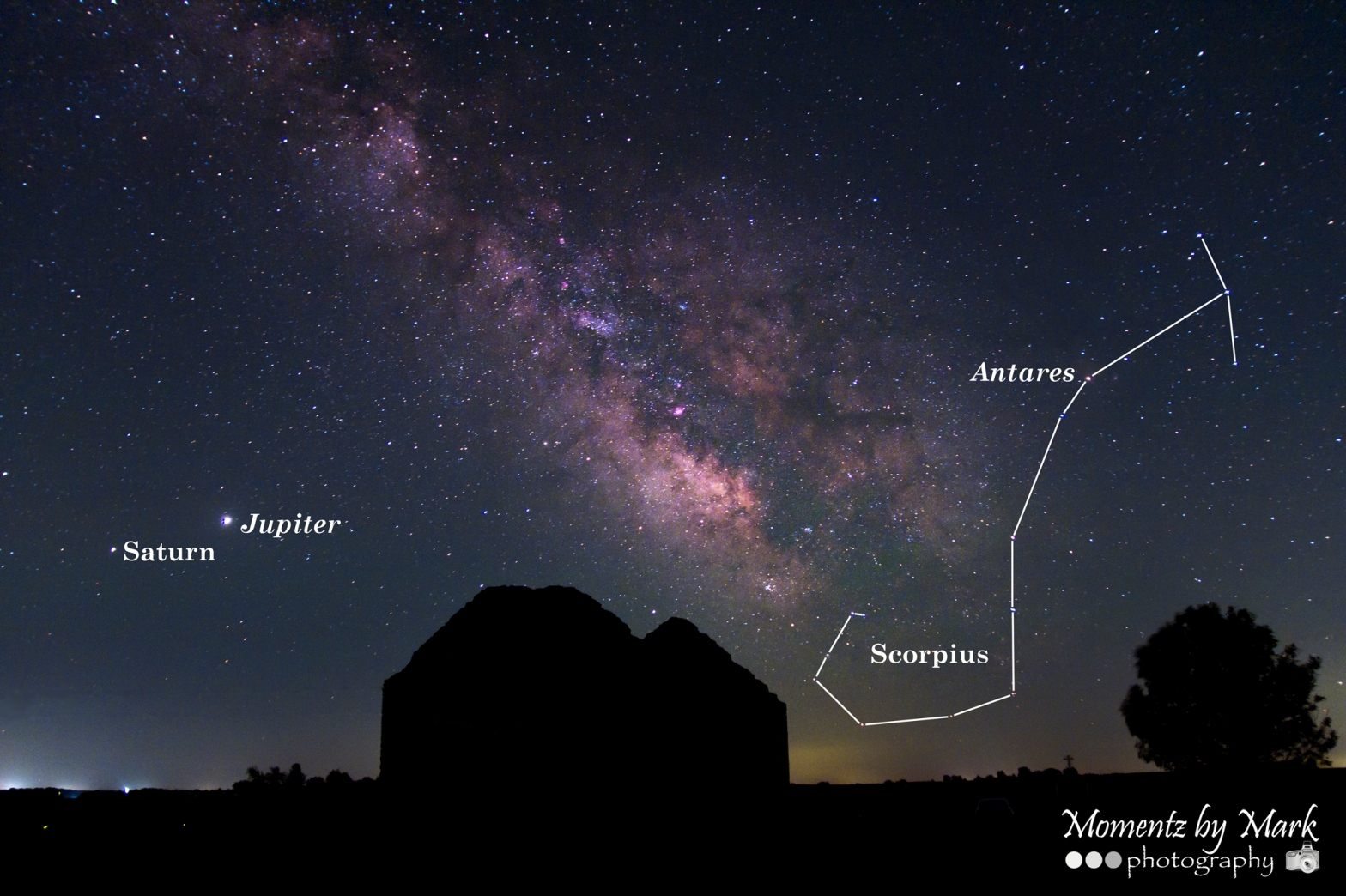Once the Sun sets on those warm summer nights and the sky begins to darken, cast your gaze opposite the Sun and look for the bright orange-red star Antares in the southeast sky. This star is well known for a number of reasons as it marks the heart of Scorpius the Scorpion. If you recall my earlier post about Orion’s (Orion the Mighty Hunter) encounter with the scorpion, and you look around, you will not find Orion and Scorpius simultaneously in the sky together. During mid to late June, Orion is located in the direction of the Sun and hidden from us.
Scorpius is one of those constellations that resemble the allegorical figure it is supposed to represent, namely, a scorpion. Some people often refer to it as the fish-hook in the sky – the fish-hook being an asterism. Above and to the right of Antares you will find three stars that form a small arc – the head of the scorpion. The stars extending from that arc, in the direction of Libra, form its claws. From the head of the scorpion, we can see how its trail of stars dips down to the southern horizon and back up again. This forms the fish-hook or the body and tail of Scorpius. Alpha Scorpii, is called Antares and is the brightest star in Scorpius. In the long winding trail of bright stars of its body, this star marks the position of the scorpion’s heart.

Antares shines just under 1st magnitude and ranks as the 16th brightest star in the night sky. But residing at the “tail end” of Scorpius is the star Shaula. Shaula, the “sting” makes the list of the 25 brightest stars in the sky, ranking close to Bellatrix in Orion. It is unfamiliar to northern observers because of its position so far south on the celestial sphere. For observers like me near or above 40 degrees north latitude, Shaula just skims the tree tops along the horizon. Shaula is the stinger in Scorpius or the barb in the fish-hook of the Polynesians. For folks in the South Pacific the entire constellation is far more prominent.
It is worth repeating that according to mythology, Orion met his death as the result of a scorpion’s sting. It was not uncommon for Orion to boast of his talents and conquests. He was especially proud of his hunting abilities and claimed that no animal alive could harm him and threatened to slay every beast upon the earth. The goddess Gaia became angry at Orion’s arrogant threat and decided to teach him a lesson. As such, she placed a scorpion along the path Orion always took on his way to his hunting grounds. Late one night, as Orion hunted in the forest, the scorpion silently waited along the path to ambush the hunter. When Orion passed by, the scorpion mortally stung the hunter in the heel – which is why when the constellation Scorpius rises in the east, Orion flees and sets below the horizon in the west. The two constellations are separated by more than 180 degrees from each other.

Antares is a type M1 red supergiant star similar to Betelgeuse and is located approximately 520 light years away. Antares is enormous in size. When viewed in visible light, Antares’ diameter is 700 larger than our Sun. But recent radio observations reveal that Antares’ atmosphere extends 2.5 times further than the star’s radius. If you placed Antares in the middle of our solar system, its outer atmosphere would extend past the orbit of Saturn swallowing up all the planets from Mercury to Saturn.

The Greeks named the planet Mars, Ares, after their god of war. They were struck by the similarity in color and brightness between Scorpius’ brightest star and Ares. Thus, they named the star “Antares”, meaning “the rival of Ares” or Mars.
Scorpius resides to the right or to the west of the brilliant band of the Milky Way – our home galaxy. On those clear dark moonless nights away from city lights, the Milky Way can be an awesome and glorious sight to behold. So don’t pass up that opportunity.
Enjoy! Good Luck and Keep Looking Up!

I think I managed to find Antares one summer night. Next time I find it, I’ll have to remember to follow the stars to Shaula as well!
LikeLiked by 1 person
BTW….Tomorrow (July1), the Moon will be to the upper right of Antares. On July 2, the Moon will be to the upper left of Antares. I hope this helps.
LikeLiked by 1 person
Thanks!
LikeLike